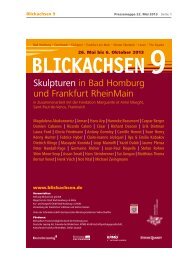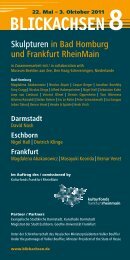Edition Scheffel - Blickachsen
Edition Scheffel - Blickachsen
Edition Scheffel - Blickachsen
Erfolgreiche ePaper selbst erstellen
Machen Sie aus Ihren PDF Publikationen ein blätterbares Flipbook mit unserer einzigartigen Google optimierten e-Paper Software.
<strong>Blickachsen</strong> 3 / Axes of View 3<br />
and the moralizing inscriptions and adoration of virtuous heroes and antiquity one believed to be able to connect with<br />
obtained their current references.” (A. v. Buttlar). Because the garden did not only include the idyll of heavenly and naively<br />
romantic images, but was also the symbolic place for “wholesome country life as contrast to the moral decay of<br />
the city” – a notion that modern day seems to have inherited.<br />
This certainly applied to English society around the time of Swift, Dickens and Hogarth, who critically witnessed<br />
the development of the English landscape garden. According to particular rules and conventions the (English) gardens<br />
were regarded as public space, “playground” and room for the emerging bourgeoisie and at the same time mirror of<br />
their enlightened ideals (Arcadia and Utopia), even when the first landscape gardens were created for suburban villas<br />
and country estates of a small group of nobility and politicians.<br />
“Happy is the man who is far from businesses” (Horaz, Oden). This “English” lifestyle was what the princely<br />
family of Hesse-Homburg liked to assume when they became aware of their “splendid mineral waters” and began to<br />
establish a suitable architectural and landscape setting. The charm of pleasure (the spa resort) benefited businesses<br />
(the casino). A visit to the spas was an ideal meeting point for those in the upper echelons of society who travelled from<br />
near and far and who regarded themselves as the elite of their nation.<br />
This social system and the interaction of the spa resort institution, that has been strictly conserved, i. e. of<br />
Kurpark and spa park, church, casino, temple and club, main and side roads, in landscapes that have been successively<br />
created since the beginning of the 1840s, is the “stage” and the “axis of view”, that have structured Bad Homburg up<br />
to now. Bourgeois tradition and quality landscape gardening once again influence the reactions of this year's artists to<br />
the palace and landscape structure, even when the artworks of Ulrichs and Vostell, Plensa and Wortelkamp with their<br />
critical and anti-illusionist features reject every cheap affirmation. For all of the participating artists, the park with its<br />
unchangeable greens, fabrics and villas, fountains, sculptures and monuments, that is, with the whole spectrum of<br />
nature and historical deep-rooted unity, represents a scale of their own art.<br />
Each artist knew accordingly, that they couldn’t use standard Land Art as is normally the case in this genre,<br />
they did not have to deal with an empty desert, but were rather forced to serve the “axes of view” that have existed for<br />
a long time as visual relations between park, landscape and architecture. The autonomy of contemporary art, which<br />
can rightly refer to the much-praised freedom of art in the tradition of the landscape garden, existed here in the shape<br />
of reduction and the return to concentration. Furthermore, most of the artists chose the places for their artworks themselves<br />
in order to take up their work after a careful study of the history and the location. The following explanations of<br />
the individual artworks will explain this notion further.<br />
When the sculptures are disassembled, the chosen places are wound up, the integrative system and the synopsis<br />
of all of this year's “axes of view” will disappear, or rather, change – a situation that occurs at the end of every exhibition.<br />
Only then does the “longing image” – to the unity of cultivated nature and (contemporary) art – have to make do<br />
with memory, just as the landscape garden constantly demands. The “idea of natural space” is, however, by no means<br />
a void, artless “emptiness”, as we have explained, but it is basically an illusionary subjective image, a kind of vision or<br />
ideal that alternates constantly between the “Garden of Desires” and monuments of art. Only the philosopher and the<br />
educated artist are concerned with this topic in its processes. Both value art according to the rule of the landscape<br />
garden as “Temple of the Virtue” and not as a “Temple of Vanity” full of “hypocrites, pedants, liberals and garrulous<br />
politicians”, as the great pioneer of the English garden William Kent (1684 - 1748) had admonished.<br />
3. Education Through Art: The New Heroes, Gods and Buddahs.<br />
Still today, a Russian orthodox priest lives in an apartment by the Kurpark's Elisabeth Fountain and is responsible<br />
for the spiritual care of the parishes of Bad Homburg and Frankfurt according to a report by the former mayor<br />
Wolfgang R. Assmann. He is the caretaker of the Russian Church of All Saints and or Russian Chapel, whose foundation<br />
stone was laid in the presence of the commissioners, Tsar Nicholas II and his wife Alexandra, born Princess Alix of<br />
Hessia, on 16th October 1896. The royal architect, Louis Benois, was called from St. Petersburg for the project.<br />
It is interesting that the Nicholas II and his wife commissioned the same architect one year later (1897) to build<br />
the Russian church for the artists' colony in Darmstadt. Ernst Ludwig (1868 - 1937) the Grand Duke of Hessen-Darmstadt<br />
was pulling the strings for both projects – the Kurpark and the artists’ colony – in his “Hessenland”, and his sister was<br />
110<br />
none other than Alix of Hessen. All of the important guests who stayed in Bad Homburg made sure that they visited the<br />
lively “Hill of the Muses”, which then began to make history as an field of experiments and “open air museum” for<br />
young artists.<br />
Both the Kurpark and Muse Hill that had been furnished with related staffage buildings and monuments, pleasure<br />
grounds and art-temple, constituted an ideal space for the search for mental and physical well-being that society<br />
sought then and still seeks today.<br />
Even a short characterisation of the Mathildenhöhe in Darmstadt serves as a historical model for the unstoppable<br />
rise of the European avant-garde and at the same time – beyond the invasion of today's banalities – provides a scale<br />
even for the search for sense and use of the present day. Furthermore, it demonstrates the complex relationship between<br />
commissioner and artist that, especially in the field of outdoor sculptures in public spaces, is still at stake today.<br />
The “<strong>Blickachsen</strong>” may smoothly take up the tradition of its own past.<br />
When Joseph Maria Olbrich 1879 - 1898 built the exhibition hall of the Vienna Secession with its cubic walls and<br />
highly decorative metal dome, he caught the attention of the Grand Duke Ernst Ludwig von Hesse.<br />
In 1899, the Grand Duke commissioned the architect to create an artists’ colony on the Mathildenhöhe in<br />
Darmstadt. It was built, along with the Hochzeitsturm (“Wedding Tower“), as the “shining” chore of a well regarded<br />
artists centre, in which seven artists – amongst others Peter Behrens – were allowed, to build, outfit and live in their<br />
houses, with total artistic freedom (completed in 1907; compared to the tower of the Bad Homburg palace). Contrary to<br />
all previous conventions, the public were given the opportunity to visit this ensemble as an artwork unto itself.<br />
The inexhaustible repertoire of nature used by Olbrich, the advocate of landscape gardens, replaced the previous<br />
dominance of eclecticism. Nature served as example and guiding principle for the design of houses, fountains,<br />
monuments, the “Swan Temple” and even the model workers' houses. Olbrich demanded not only an isolated “Muse<br />
hill”: “We must build a city, a whole city. Everything else is nothing! The government should give us a field, and this will<br />
be where we want to create a world.”<br />
This search for a new, better “world” was to complement the repetitiveness and rigidity of the cities in separate<br />
refuges of intense variety and surprises, motives which, as we have seen, are essential of the spa garden and landscape<br />
garden.<br />
Henry van de Velde, one of the founding fathers of the new art (art nouveau), demanded “ to follow a line which<br />
is able perform the wonder of filling the our environment with breath and song.” This humane dimension seems to<br />
represent a sharp contrast to the purely mechanical and industrial dimension of iron and steel constructions.<br />
Nevertheless, the desperately needed machines, according to van de Velde, were regarded as “creations of a higher<br />
level”. He compared the machine with “heroes, gods and buddahs, who squat pensively on their pedestals and disappear<br />
when more beautiful creations are born.”<br />
The sculptor Bernhard Hoetger was able to take on this role for the Mathildenhöhe. Under the motto “Kreislauf<br />
des Lebens“ (“The Cycle of Life”) he decorated the plane tree grove beneath the Hochzeitsturm with statues and<br />
reliefs. He included Asian inspired figures of “light and shadow”, the “vase carriers” or the “summer”. With his complex<br />
program, Hoetger belongs to one of the first sculptors who set out to furnish a demarcated outside area with sculptures<br />
in the spirit of a total artwork and to create a network of communicating “axes of view”.<br />
From the interplay between the “idylls” (Bad Homburg and Mathildenhöhe) that are both situated on hills and<br />
are topographically also close to each other, a conclusion is: The landscape garden requiring limitless nature and<br />
freedom for recreation and healing (Bad Homburg) and the artists’ colony Mathildenhöhe in Darmstadt supplement<br />
each other once again to the dual concept of Arcadia and Utopia, both in tradition and modernity. Only those who respect<br />
the freedom of art and nature will reach modernity’s “higher level” in the present and the future. Limitation and<br />
restriction means curtailment. Just as the great philosopher of Enlightenment Jean-Jacques Rousseau (1712 - 1778)<br />
used the pruning of plants as metaphor for bad upbringing, it can also destroy artistic imagination. Without imagination,<br />
no images can be created, as we have already heard, and no emotion will rise on the horizon of freedom.<br />
The community of all artists who present themselves for a time in any sculpture garden and in “<strong>Blickachsen</strong>”<br />
has to feel obliged to the notion of this concept of freedom within tradition and modernity, if they want their subject<br />
matter and designs to be taken seriously. Additionally, the artworks of our time may show us totally different features,<br />
as is evident in “<strong>Blickachsen</strong> 3”. From the tension between nature and technology, construction and person on one<br />
side, and in the attempt to come to terms with the guidelines of the locations on the other, new “heroes, gods and<br />
buddhas” will arise.<br />
111






